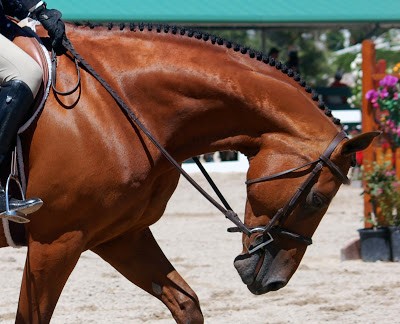
Effect of head-neck positions on muscle activity in the neck
The knowledge of muscle activity in neck muscles is essential for making judgements on head-neck positions (HNPs) commonly used by riders. The question what the influence of frequently used HNPs is on the body and welfare of the horse can be answered using various methods. This study used electromyography (EMG) to measure muscle activity of three important neck muscles in three different head-neck positions in the horse.
In this study five warmblood horses were tested, both with and without rider, in all three gaits on both hands. With the use of a draw rein the horses were positioned in a free, gathered and hyperflexed position. The muscle activity of the m. brachiocephalicus, m. splenius and m. trapezius were measured in these three different positions.
Results showed a significantly higher activity in the m. brachiocephalicus in the hyperflexed position in all gaits, when compared to the other two HNPs. In contrast to the m. brachiocephalicus, the m. splenius showed less activity in the hyperflexed position. Highest activity was recorded during the free position in all gaits. The m. trapezius was significantly less active in walk and trot in the hyperflexed position, and showed highest activity in the free position. In the canter, the activities of the m. trapezius showed no differences between HNPs. Furthermore, results showed no differences between ridden and non-ridden horses.
The authors concluded that training with HNPs in front of the vertical leads to activation of muscles of the topline (m. splenius, m. trapezius). Training horses in a hyperflexed position leads to activation of the m. brachiocephalicus, a major muscle of the lower topline. In extreme cases this can lead to spasms of the m. brachiocephalicus, which can results in pain and is in conflict with animal welfare.
Expert opinion by Debby Gudden
Hyperflexion of the horse’s neck is currently used as a training method by a number of high-level competition dressage riders, and increasingly used by eventers and show-jumpers. The use of hyperflexion is controversial as it may affect the horse’s welfare by causing discomfort. When training your own horse it is important to change head-neck positions regularly, especially when training in a hyperflexed position to prevent acidification and spasms of the muscles. Make sure your horse can recover sufficiently from its training and by doubt always advise your instructor. Training in hyperflexion can lead to serious (muscle) damage and injuries which is in conflict with animal welfare.
> From: Kienapfel, J Anim Physiol Anim Nutr 99 (2014) 132-138. All rights reserved to Blackwell Verlag. Click here for the online summary.


